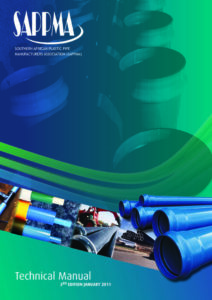SAPPMA has published and released a third revision of its technical manual, which is aimed at assisting engineers who are involved in the plastic pipe industry to make informed decisions.
“The purpose of this manual is to provide basic, relevant information and the guidance needed to ensure that plastic pipes for water supply and wastewater disposal applications are correctly specified and selected,” explains Southern African Plastic Pipe Manufacturer’s Association (SAPPMA)CEO, Jan Venter. Although this manual does not attempt to replace published text books and codes on the subject, Venter says that it is a basic guide to the use, selection and specification of these products. It covers the differences between the various types of plastic pipes and the basic procedures for determining product size, strength and material properties for a range of applications. The latest revision also includes sections on hot and cold water plumbing pipes;high-density polyethylene (HDPE) fabricated fittings as well as the jointing of HDPE. For a limited period copies of the publication have been made available to design and civil engineers free of charge throughthe South African Institution of Civil Engineering,and as a service to the industry. “Together with the country’s networks of roads, railways and electrical grids, pipelines form a key part of South Africa’s infrastructure. By definition, these investments in infrastructure should be long-term. Modern plastic pipe materials are easily suitable for hundred year lifetimes and we want to ensure that the engineers involved in specification processes are equipped with the most recent and independent design information when they are making their decisions,” explains Venter. Thanks to ongoing product development, innovation and research plastic pipes have become the material of choice for most applications in South Africa and the rest of the world. Not only do they help to preserve scarce resources due to an embedded energy that is notably lower than most other materials, plastic pipes also play a significant role in minimising pumping energy as they have excellent hydraulic properties that remain virtually unchanged.Handling of plastics is significantly easier and cheaper than other materials and leak-free joints are economically and easily achieved. “However, poor quality plastic pipe is not necessarily obvious from a visual point of view, which makes it even more important for design engineers or specifiers to apply all available precautions in the selection of manufacturers, suppliers and installers,” warns Venter, adding that pipe manufacturers and installers who are members of SAPPMA and the Installation and Fabrication Plastics Pipe Association(IFPA) are subjected to additional quality control measures over and above the national standards. IFPA and its parent body, SAPPMA, have recently made a bend testing machine available for training and testing purposes at the Plastics SA head office in Gauteng.Bend testing is a quick and very effective way of determining the quality of fusion of butt welds. According to Venter the bend testing machine is used for quality assurance of butt welds done by contractors, as well as those done during training sessions hosted by Plastics SA.
“We have identified that a huge need exists for experienced butt welders in the plastics industry,” says Venter, explaining that a well-engineered pipe system is dependent on good design, high pipe quality as well as minimum standards at the downstream end, which includes looking at the quality of fabricated fittings and pipeline installation. “SAPPMA realised what tremendous benefit it would unlock for the plastic pipe industry if we were to make a bend tester available,which could practically test and judge the quality of butt welding on pipes manufactured from HDPE and PVC. Not only does Plastics SA offer practical, hands-on training on the bend tester for its students, but it also makes an operator available should any of its members wish to perform their own tests,” continues Venter. The concept of a bend test for welds is simple: A narrow strip is cut from the welded joint, longitudinally with the pipe. This strip of material is prepared to a determined shape and finish. The finished sample is inserted in the machine and bent at a specified rate into a U-shape. No cracks should appear at the weld area during the process. The purpose is to make certain the plastic material of the two pipes are properly fused, and that the weld and the heat affected zone (HAZ) have appropriate mechanical properties. Usually, bend tests are designed so that the outer surface of the specimen is stretched to a ductility level,which approximates the minimum percentage elongation required in a tensile test. When defects exist in materials strained to these limits, the material tears locally. When tearing exceeds a specific limit, the specimen fails. “The plastic piping business is a strategic industry and hardware needs to be reliable for extended periods of time. Long-term product and installation quality is therefore fundamental. By making this investment into the future of the plastic pipe industry, we are confident that we will see a marked improvement in the quality of butt welds and therefore in pipe installations in general in the next months to come,” concludes Venter.







